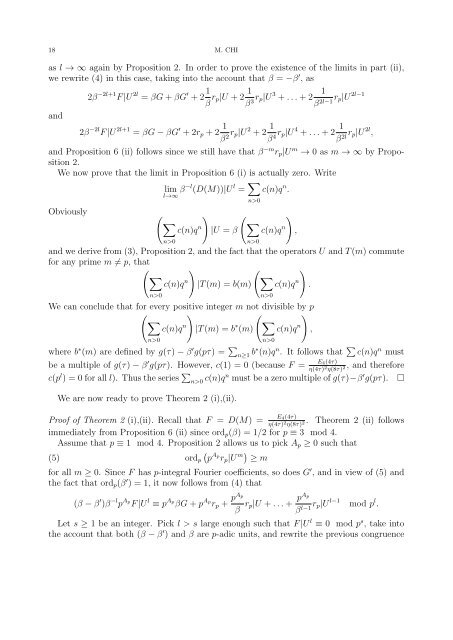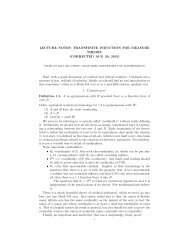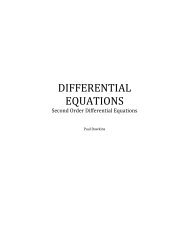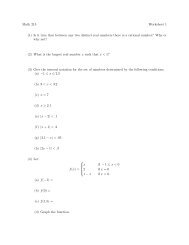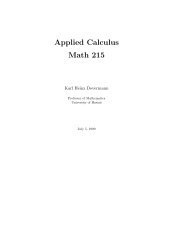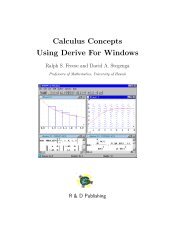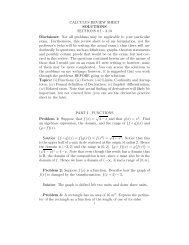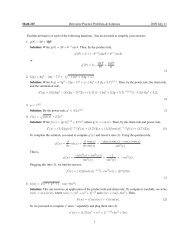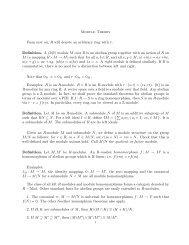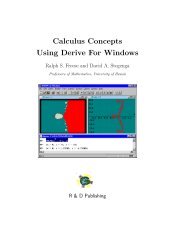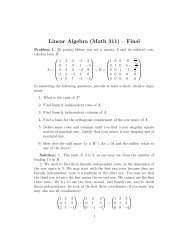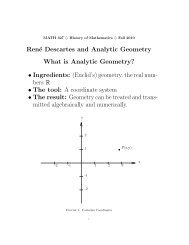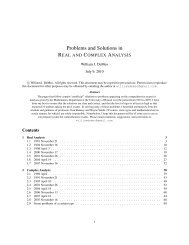MA thesis available - University of Hawaii
MA thesis available - University of Hawaii
MA thesis available - University of Hawaii
Create successful ePaper yourself
Turn your PDF publications into a flip-book with our unique Google optimized e-Paper software.
18 M. CHI<br />
as l → ∞ again by Proposition 2. In order to prove the existence <strong>of</strong> the limits in part (ii),<br />
we rewrite (4) in this case, taking into the account that β = −β ′ , as<br />
2β −2l+1 F |U 2l = βG + βG ′ + 2 1<br />
β rp|U + 2 1<br />
β3 rp|U 3 + . . . + 2 1 2l−1<br />
rp|U<br />
β2l−1 and<br />
2β −2l F |U 2l+1 = βG − βG ′ + 2rp + 2 1<br />
β 2 rp|U 2 + 2 1<br />
β 4 rp|U 4 + . . . + 2 1<br />
β 2l rp|U 2l ,<br />
and Proposition 6 (ii) follows since we still have that β −m rp|U m → 0 as m → ∞ by Proposition<br />
2.<br />
We now prove that the limit in Proposition 6 (i) is actually zero. Write<br />
lim<br />
l→∞ β−l (D(M))|U l = <br />
n>0<br />
c(n)q n .<br />
Obviously <br />
<br />
c(n)q n<br />
<br />
<br />
|U = β c(n)q n<br />
<br />
,<br />
n>0<br />
and we derive from (3), Proposition 2, and the fact that the operators U and T (m) commute<br />
for any prime m = p, that<br />
<br />
c(n)q n<br />
<br />
<br />
<br />
|T (m) = b(m) c(n)q n<br />
<br />
.<br />
n>0<br />
We can conclude that for every positive integer m not divisible by p<br />
<br />
<br />
c(n)q n<br />
<br />
|T (m) = b ∗ <br />
<br />
(m) c(n)q n<br />
<br />
,<br />
n>0<br />
where b ∗ (m) are defined by g(τ) − β ′ g(pτ) = <br />
n≥1 b∗ (n)q n . It follows that c(n)q n must<br />
be a multiple <strong>of</strong> g(τ) − β ′ g(pτ). However, c(1) = 0 (because F = E4(4τ)<br />
η(4τ) 2 η(8τ) 2 , and therefore<br />
c(p l ) = 0 for all l). Thus the series <br />
n>0 c(n)qn must be a zero multiple <strong>of</strong> g(τ)−β ′ g(pτ). <br />
We are now ready to prove Theorem 2 (i),(ii).<br />
Pro<strong>of</strong> <strong>of</strong> Theorem 2 (i),(ii). Recall that F = D(M) = E4(4τ)<br />
η(4τ) 2 η(8τ) 2 . Theorem 2 (ii) follows<br />
immediately from Proposition 6 (ii) since ordp(β) = 1/2 for p ≡ 3 mod 4.<br />
Assume that p ≡ 1 mod 4. Proposition 2 allows us to pick Ap ≥ 0 such that<br />
Ap (5) ordp p rp|U m ≥ m<br />
for all m ≥ 0. Since F has p-integral Fourier coefficients, so does G ′ , and in view <strong>of</strong> (5) and<br />
the fact that ordp(β ′ ) = 1, it now follows from (4) that<br />
(β − β ′ )β −l p Ap F |U l ≡ p Ap βG + p Ap rp + pAp<br />
β rp|U + . . . + pAp<br />
β l−1 rp|U l−1 mod p l .<br />
Let s ≥ 1 be an integer. Pick l > s large enough such that F |U l ≡ 0 mod p s , take into<br />
the account that both (β − β ′ ) and β are p-adic units, and rewrite the previous congruence<br />
n>0<br />
n>0<br />
n>0


